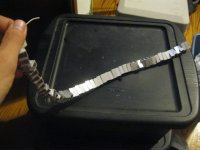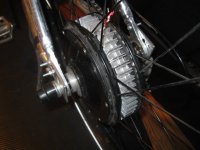I am intent on cooling my Mac, in some fashion. Yeah, I might be babying it, but at 87 C and only 94 F outside temps (we get to 110) without riding it hard, I feel I am right near the edge and want to take some precautions. I am running 1200watt peak btw, so not all that high power. Usually average 400-500watts over 10-20 minute trips. 18-22wh/mile.
I will start by asking, why can't you drill the drive side cover on a Mac? It's separate from the gear side.
I am experimenting with attaching custom heat sinks.
Other ideas are:
- Build a sun shade (very marginal help)
- Attach a fan to use when stopped at a light, or while parked etc.
- Water spraying system to use while moving
Does anyone have any data on the actual healthy limits of a Mac? Temperature next to the windings? (heat sensor installed). At one end, some members say 80 C is where magnets start losing power (I haven't noticed any drop in power). On the other end, members are saying 200 C is possible for short bursts (on a DD).
I will start by asking, why can't you drill the drive side cover on a Mac? It's separate from the gear side.
I am experimenting with attaching custom heat sinks.
Other ideas are:
- Build a sun shade (very marginal help)
- Attach a fan to use when stopped at a light, or while parked etc.
- Water spraying system to use while moving
Does anyone have any data on the actual healthy limits of a Mac? Temperature next to the windings? (heat sensor installed). At one end, some members say 80 C is where magnets start losing power (I haven't noticed any drop in power). On the other end, members are saying 200 C is possible for short bursts (on a DD).




